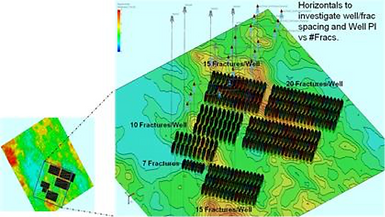

Tight Gas and Oil Production (Unconventionals)
For the last 15 years shale gas and more recently shale oil production has been a technical success in North America. Commercially, the extraction of this unconventional gas and oil still faces challenges. The technical success of extracting gas and oil from microdarcy or nanodarcy formations has relied on the combination of horizontal well drilling combined with the placement of numerous staged hydraulic fractures along these horizontal laterals, firstly adopted by Maersk in Denmark in the early 1990s and more recently enhanced on the US 'shale' plays. Typically in North America, the lateral is sub-divided into 20 to 30 stages and subjected to hydraulic fracturing, with the aim of generating multiple parallel hydraulic fracture planes orientated perpendicular to the wellbore axis: transverse fractures.
In Europe and the MEAP region unconventional resources as well as more marginal resources with low permeabilities - in the region of 0.01 to 10 md are also now increasingly targeted using the same technologies.
During Exploration and Appraisal well drilling of these tight resources, characterising the stress regime is critical for interval selection, and to ensure that hydraulic fracturing generates vertical fractures which are vertically constrained. Determining the horizontal stress orientation over the field is also critical for determining the placement of monitoring and surveillance wells for microseismic surveys, and for planning future lateral well orientations.
For the development stages geomechanics design affects a number of major aspects of the exploitation of tight gas and oil and unconventional developments, including:
-
Stress regime - should be normal or strike-slip in order to generate vertical hydraulic fractures (though standard industry calculation methods can lead to unrealistic estimates and stress characterisations),
-
The lateral wells should be drilled parallel to one of the horizontal stress directions for optimum alignment between the hydraulic fracture and the wellbore,
-
Minimum horizontal stress profiles determine the likelihood of fracture containment, the likely fracture profile, and allowable injection pressures,
-
the mechanical properties help assess the design and geometry of fractures, such as the fracture width,
-
For shale plays the brittleness of the formation and the minimum horizontal stress magnitudes are key input parameters if the lateral completion is to be customised, to avoid uneven fracture development,
-
Wellbore stability in the shale layers is required for proper wellbore access and sealing with either cement or packers along the lateral.
1D and 3D MEMs can help in defining optimum locations for completion as well as provide input to these well and fracturing design considerations.

Bakken map from National Geographic



Publications
-
Doucette, N., Ziller, M. and Addis, T. (2018). Characterising and Defining Stimulation Zones in Tight Formations for Appraisal Wells Onshore U.A.E. with the Aid of Integrated Standard and Novel Stress Determination Methods. SPE 193032. Abu Dhabi International Petroleum Exhibition and Conferenceheld in Abu Dhabi, UAE, 12–15 November 2018.
-
Michael A. Addis, Sanjeev Bordoloi, Javier A. Franquet, Patrick J. Hooyman, Robert S. Hurt, Julie E. Kowan, Abbas Khaksar, Neal B. Nagel, and See H. Ong (2016). Role of Geomechanical Engineering in Unconventional Resources Developments.Chapter 9, p.43. Unconventional Oil and Gas Resources: Exploration and Development. (eds) Usman Ahmed and D. Nathan Meehan. CRC Press, Taylor and Francis, ISBN9781498759403.
-
Michael A. Addis, Hans-Christian Freitag, and Alfredo Mendez, (2016). Pilot Projects in Unconventional Resources Development. Chapter 7, p.12. Unconventional Oil and Gas Resources: Exploration and Development. (eds) Usman Ahmed and D. Nathan Meehan. CRC Press, Taylor and Francis, ISBN9781498759403.
-
Michael A. Addis, Hans-Christian Freitag, Alfredo Mendez, and Roberto Ceccarelli (2015). The Role of Pilot Projects in the Development of Unconventional Resources. SPE 17783. Abu Dhabi International Petroleum Exhibition and Conferenceheld in Abu Dhabi, UAE, 9–12 November 2015
-
Addis, M.A. & Yassir, N. 2010. Geomechanical Engineering of Tight Gas Sand Developments. SPE 136919. SPE/DGS Annual Technical Symposium and Exhibitionheld in Al-Khobar, Saudi Arabia, 04–07 April 2010